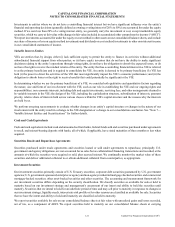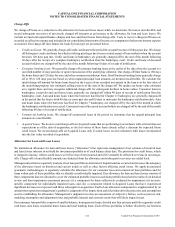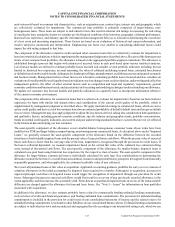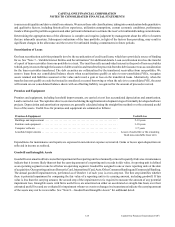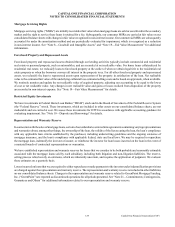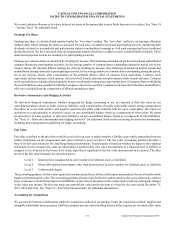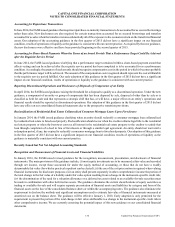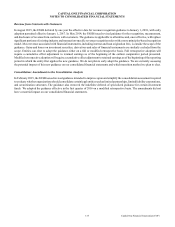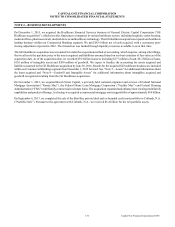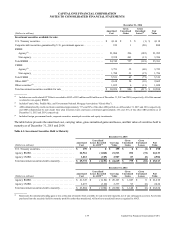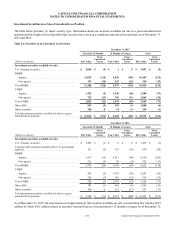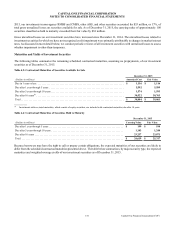Capital One 2015 Annual Report Download - page 150
Download and view the complete annual report
Please find page 150 of the 2015 Capital One annual report below. You can navigate through the pages in the report by either clicking on the pages listed below, or by using the keyword search tool below to find specific information within the annual report.CAPITAL ONE FINANCIAL CORPORATION
NOTES TO CONSOLIDATED FINANCIAL STATEMENTS
131 Capital One Financial Corporation (COF)
When presented on a net basis, the loss sharing amounts due from partners are recorded as a reduction to our provision for credit
losses on our consolidated statements of income and reduce the charge-off amounts that we report. The allowance for loan and
lease losses attributable to these portfolios are also reduced by the loss sharing amount due from the partners. See “Note 6—
Allowance for Loan and Lease Losses” for additional information related to our loss sharing arrangements.
Collaborative Arrangements
A collaborative arrangement is a contractual arrangement that involves a joint operating activity between two or more parties that
are active participants in the activity. These parties are exposed to significant risks and rewards based upon the economic success
of the joint operating activity. We assess each of our partnership agreements with profit, revenue or loss sharing payments to
determine if a collaborative arrangement exists and, if so, how revenue generated from third parties, costs incurred and transactions
between participants in the collaborative arrangement should be accounted for and reported on our consolidated financial statements.
We currently have one partnership agreement that meets the definition of a collaborative agreement.
We share a fixed percentage of revenues, consisting of finance charges and late fees, with the partner, and the partner is required
to reimburse us for a fixed percentage of credit losses incurred. Revenues and losses related to the partner’s credit card program
and partnership agreement are reported on a net basis in our consolidated financial statements. Revenue sharing amounts attributable
to the partner are recorded as an offset against total net revenue in our consolidated statements of income. Interest income was
reduced by $1.1 billion, $1.0 billion and $965 million in 2015, 2014, and 2013, respectively, for amounts earned by the partner,
as part of the revenue sharing agreement. The financial statement impact of all of our loss sharing arrangements that qualify for
net accounting treatment is disclosed in “Note 6—Allowance for Loan and Lease Losses.”
Stock-Based Compensation
We reserve common shares for issuance to employees, directors and third-party service providers, in various forms, including
stock options, stock appreciation rights, restricted stock awards and units and performance share awards and units. In addition,
we also issue cash equity units and cash-settled restricted stock units which are not counted against the common shares reserved
for issuance or available for issuance because they are settled in cash. For awards settled in shares, we generally recognize
compensation expense on a straight-line basis over the award’s service period. If an award settled in shares contains a performance
condition with graded vesting, we recognize compensation expense using the accelerated attribution method. Equity units and
restricted stock units that are cash-settled are accounted for as liability awards which results in quarterly expense fluctuations based
on changes in our stock price through the date that the awards are settled. Awards that continue to vest after retirement are expensed
over the shorter of the period of time between the grant date and the final vesting period or between the grant date and when the
participant becomes retirement eligible; awards to participants who are retirement eligible at the grant date are subject to immediate
expense recognition upon grant. Stock-based compensation expense is included in salaries and associate benefits in the consolidated
statements of income.
Stock-based compensation expense for equity classified stock options is based on the grant date fair value, which is estimated
using a Black-Scholes option pricing model. Significant judgment is required when determining the inputs into the fair value model
and the expected forfeiture rate of stock options. For awards other than stock options, the fair value of stock-based compensation
used in determining compensation expense will generally equal the fair market value of our common stock on the date of
grant. Certain share-settled awards have discretionary vesting conditions which result in a requirement to remeasure at fair value
each reporting period and potential for compensation expense to fluctuate with changes in our stock price.
Marketing Expenses
We expense marketing costs as incurred. Television advertising costs are expensed during the period in which the advertisements
are aired.
Income Taxes
We recognize the current and deferred tax consequences of all transactions that have been recognized in the financial statements
using the provisions of the enacted tax laws. Current income tax expense represents our estimated taxes to be paid or refunded for
the current period and includes income tax expense related to our uncertain tax positions, as well as tax-related interest and penalties.
Deferred tax assets and liabilities are determined based on differences between the financial reporting and tax basis of assets and
liabilities and are measured using the enacted tax rates and laws that will be in effect when the differences are expected to reverse.


